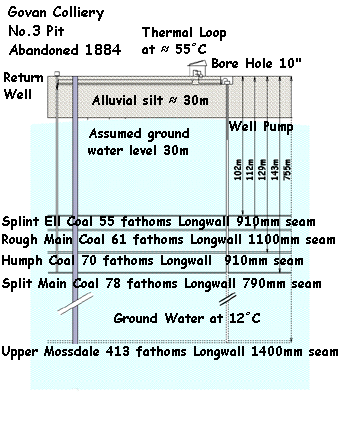
Heating Supply from an Old Mine

 |
Heating Supply from an Old Mine |
 |
| Heating the domestic environment, both space and hot water, can often be the largest part of an energy bill, up to 80% in some cases. Choosing sources and picking heating media is important for any home, and the choices made by developers in the initial stages can have a large impact on subsequent options. |
|
After locating and studying some old maps of the proposed Oatlands development site,
we discovered that there lies within the bounds of the site an old colliery. With
further investigation we came across old mining maps from the late 1800's which showed
that this area was extensively mined in the latter part of the 19th Century.
From this we investigated the possibility of drawing heat from water in old coal mines.
This is indeed a very viable means of supplying heat to dwellings, and a similar project already exists in Shettleston, on the outskirts of Glasgow. In Shettleston, a small group of dwellings have all their heating and hot water needs catered for by heat from water drawn up from deep mines, and then upgraded via engine-driven heatpumps, where the water is initially heated by the heat pump, and then passes through the cooling circuit of the engine to be heated further. This is a very interesting prospect for the Oatlands development, and becomes even more attractive when one considers that the longwall seams that were exploited in Shettleston are the same as those exploited underneath Oatlands. This could give an indication of the viability of this system. |
| The seams detailed here are those that were exploited in the Govan Colliery in the 19th Century. These were the same seams that were mined at Shettleston, and are now being successfully used as a source of heat for a small community. |  |
|
We are recommending that a similar scheme be installed in the Oatlands development project.
Admittedly the Oatlands project is a much larger scale, but reports from the site have
suggested that there is plenty of heat available. Also, the area underneath Oatlands was
mined extensively, and there is likely to be a plentiful resource available. There is a possibility that the heat extracted will not be sufficient to heat the entire development, however any inroads it could make into lowering the oatlands heating bill would be warmly welcomed. |
External Reference Links:
Monitoring and evaluation of Local authority energy efficiency schemes.
District Heating Network in Shetland.
Project on Shettleston Community Heating scheme.
![]() Return to main Proposals page
Return to main Proposals page